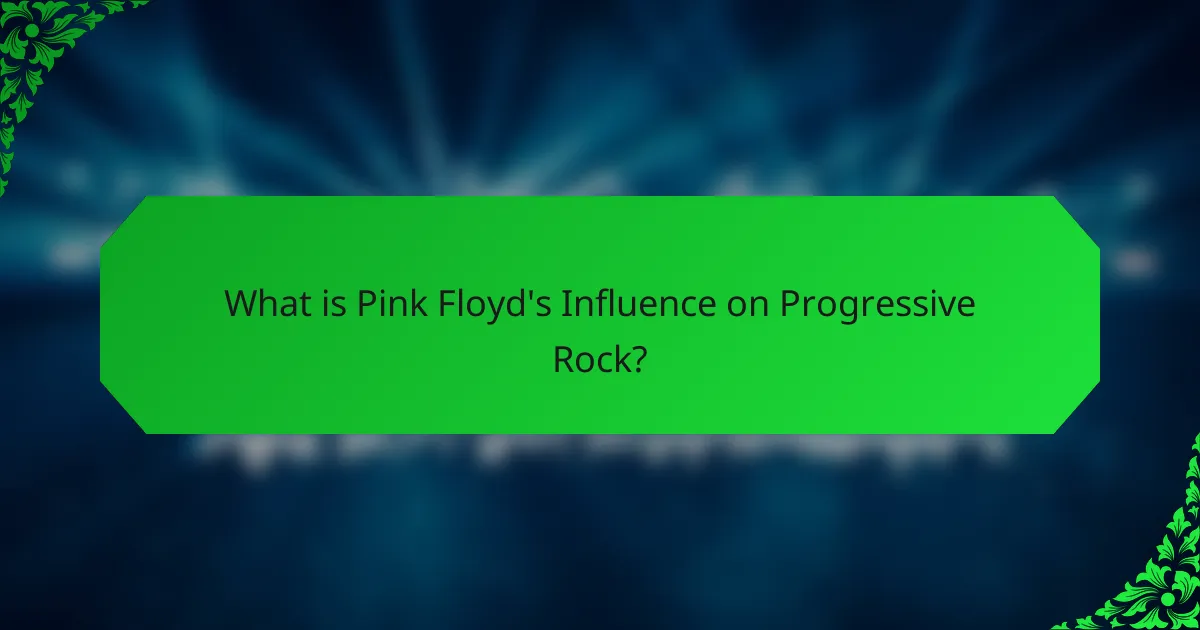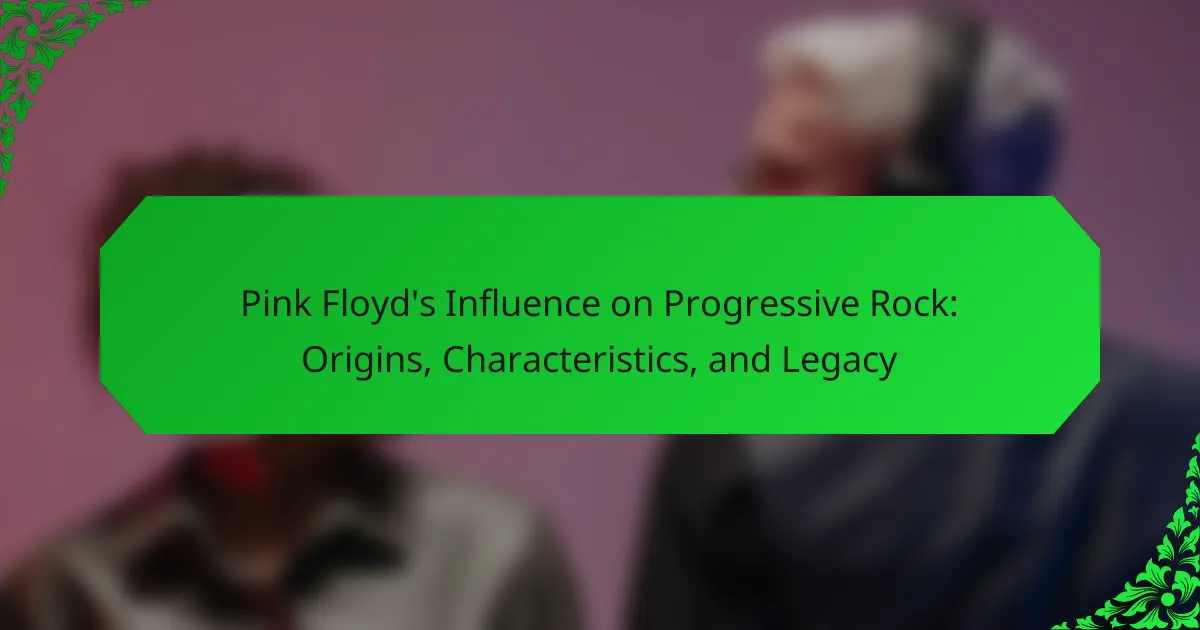Pink Floyd is a seminal band known for its profound impact on the progressive rock genre. Their innovative sound, characterized by complex song structures and conceptual storytelling, was exemplified in the landmark album “The Dark Side of the Moon.” This album not only set a standard for thematic coherence but also incorporated diverse musical influences, including jazz and classical elements. The band’s pioneering use of synthesizers and elaborate live performances further expanded the possibilities of progressive rock. Pink Floyd’s exploration of existential themes and their influence on subsequent artists, such as Genesis and Yes, solidified their legacy and continued to shape the genre.

What is Pink Floyd’s Influence on Progressive Rock?
Pink Floyd significantly influenced progressive rock through their innovative sound and thematic depth. Their album “The Dark Side of the Moon” introduced complex song structures and conceptual storytelling. This work became a benchmark for the genre, blending rock with jazz and classical elements. The band’s use of synthesizers and experimental soundscapes expanded the sonic possibilities of progressive rock. Their live performances incorporated elaborate visuals, setting a standard for theatricality in concerts. Pink Floyd’s exploration of existential themes resonated deeply with audiences, influencing many subsequent artists. Bands like Genesis and Yes drew inspiration from Pink Floyd’s musical and lyrical styles. Their legacy continues to shape the progressive rock genre today.
How did Pink Floyd contribute to the development of progressive rock?
Pink Floyd significantly contributed to the development of progressive rock through their innovative sound and conceptual albums. Their 1973 album “The Dark Side of the Moon” introduced complex musical structures and thematic coherence. This album is one of the best-selling records of all time, demonstrating their widespread influence. Pink Floyd incorporated elements of psychedelia, jazz, and classical music into their work. They utilized studio techniques like multi-tracking and sound effects, which were groundbreaking at the time. Their live performances often featured elaborate visual effects, enhancing the overall experience. The band’s exploration of philosophical and existential themes in their lyrics set a precedent for future progressive rock artists. Overall, Pink Floyd’s artistic vision and experimentation helped to define and expand the boundaries of the genre.
What key albums mark Pink Floyd’s influence in the genre?
The key albums that mark Pink Floyd’s influence in the genre include “The Dark Side of the Moon,” “Wish You Were Here,” “Animals,” and “The Wall.” “The Dark Side of the Moon,” released in 1973, is renowned for its innovative use of studio effects and concept album format. It spent 741 weeks on the Billboard 200 chart, showcasing its enduring popularity. “Wish You Were Here,” released in 1975, pays tribute to former band member Syd Barrett and features the iconic track “Shine On You Crazy Diamond.” “Animals,” released in 1977, critiques capitalism and social issues through its animal allegory. Lastly, “The Wall,” released in 1979, is a rock opera that explores themes of isolation and personal trauma, becoming one of the best-selling albums of all time. These albums collectively shaped the sound and thematic depth of progressive rock, influencing countless artists and bands.
How did their musical style evolve over time?
Pink Floyd’s musical style evolved significantly from their inception in the mid-1960s to the late 1970s. Initially, they embraced a psychedelic rock sound characterized by experimental effects and surreal lyrics. Their early albums, such as “The Piper at the Gates of Dawn,” showcased this style with extended instrumental passages and innovative soundscapes.
As they progressed, particularly with “The Dark Side of the Moon,” they incorporated more structured compositions and thematic cohesion. This shift marked a transition towards progressive rock, emphasizing conceptual storytelling and complex arrangements. The use of synthesizers and studio effects became more prominent during this period.
In the late 1970s, with “Animals” and “The Wall,” their style further evolved to include social and political commentary, reflecting darker themes. The incorporation of rock opera elements in “The Wall” highlighted their ability to blend narrative with music. Overall, Pink Floyd’s evolution showcased a journey from psychedelic roots to a sophisticated progressive rock sound, influencing countless artists and genres.
What are the defining characteristics of Pink Floyd’s music?
Pink Floyd’s music is characterized by its innovative use of sound, conceptual themes, and elaborate compositions. Their incorporation of progressive rock elements creates a unique auditory experience. The band often explores existential themes, reflecting on human experience and society. Their albums, such as “The Dark Side of the Moon,” showcase seamless transitions between tracks. Pink Floyd frequently utilizes extended instrumental sections, enhancing emotional depth. The use of synthesizers and sound effects adds layers to their music. Lyrically, they often collaborate with Roger Waters, known for his poignant storytelling. Their live performances are renowned for elaborate visual elements and immersive experiences.
How do themes and lyrics shape their sound?
Themes and lyrics significantly shape Pink Floyd’s sound by providing emotional depth and narrative context. The band’s exploration of complex themes like alienation, mental health, and societal critique informs their musical arrangements. For instance, the lyrics in “The Wall” convey a story of isolation, which is reflected in the somber tones and atmospheric instrumentation. This thematic focus creates a unique soundscape that enhances the listener’s experience. Additionally, the use of sound effects and innovative production techniques complements the lyrical content. The interplay between lyrics and music allows for a cohesive artistic expression, making their sound distinctive in the progressive rock genre.
What role do instrumentation and production techniques play?
Instrumentation and production techniques are crucial in defining Pink Floyd’s sound. They contribute to the band’s atmospheric quality and complex compositions. Unique instrumentation, such as synthesizers and unconventional instruments, creates distinctive sonic textures. Production techniques, including multi-layering and innovative use of reverb, enhance the immersive experience. For example, the use of the EMS Synthi AKS synthesizer in “On the Run” exemplifies their pioneering approach. The band’s meticulous studio work, particularly in albums like “The Dark Side of the Moon,” showcases their commitment to sonic experimentation. This focus on instrumentation and production has significantly influenced the progressive rock genre.
Why is Pink Floyd considered a pioneer in the progressive rock movement?
Pink Floyd is considered a pioneer in the progressive rock movement due to their innovative use of sound and thematic complexity. They incorporated experimental techniques like extended instrumental sections and concept albums. Their 1973 album “The Dark Side of the Moon” exemplified these traits, achieving commercial success and critical acclaim. The album’s exploration of mental health and existential themes resonated widely, influencing countless artists. Furthermore, their incorporation of visual elements in live performances set a new standard in the music industry. Pink Floyd’s work laid the groundwork for future progressive rock bands, cementing their legacy as trailblazers in the genre.
What innovations did they introduce to the genre?
Pink Floyd introduced several innovations to the progressive rock genre. They pioneered the use of concept albums, creating cohesive narratives throughout their records. Their album “The Dark Side of the Moon” integrated themes of mental health and existentialism, which was groundbreaking. They also utilized advanced studio techniques, such as multitrack recording and sound effects. This experimentation enhanced the overall listening experience. Additionally, their incorporation of visual elements in live performances set new standards for concert experiences. The use of synthesizers and electronic instruments expanded the sonic palette of progressive rock. These innovations significantly influenced countless artists and shaped the direction of the genre.
How did their live performances set them apart?
Pink Floyd’s live performances set them apart through their innovative use of visual effects and elaborate stage designs. They incorporated large-scale projections, laser shows, and intricate lighting to enhance the musical experience. Their concerts often featured thematic storytelling, creating a cohesive narrative throughout the performance. The incorporation of multimedia elements was groundbreaking, making their shows a sensory experience. For instance, the use of inflatable props like the giant pig in “Animals” became iconic. Their commitment to artistic expression transformed live music into a theatrical event. This unique approach contributed to their reputation as pioneers in the progressive rock genre.

What are the key origins of Pink Floyd’s music?
Pink Floyd’s music originated from the fusion of various musical influences and artistic concepts. The band was formed in 1965 in London. Early influences included blues, psychedelic rock, and avant-garde music. Syd Barrett’s innovative songwriting and guitar work were pivotal in shaping their sound. The band’s use of experimental studio techniques further defined their musical identity. Their debut album, “The Piper at the Gates of Dawn,” showcased their early psychedelic style. Over time, their music evolved to incorporate progressive rock elements. Themes of alienation and existentialism became central to their later works, particularly in “The Dark Side of the Moon.”
How did the band’s formation influence their musical direction?
The band’s formation significantly influenced their musical direction by establishing a collaborative and experimental ethos. Pink Floyd was formed in 1965 by Syd Barrett, Roger Waters, Nick Mason, and Richard Wright. Their early focus on psychedelic rock shaped their sound, as seen in their debut album “The Piper at the Gates of Dawn.” The group’s initial lineup allowed for diverse musical influences, blending rock, jazz, and avant-garde elements. Barrett’s creative vision drove their early experimentation with sound and lyrics. As the band evolved, Waters and Gilmour’s contributions shifted their style towards progressive rock. This transition is evident in albums like “The Dark Side of the Moon,” which showcased complex compositions and thematic depth. The collaborative nature of their formation laid the groundwork for their innovative approach to music.
What were the early influences on their sound?
Pink Floyd’s early sound was influenced by various musical styles and cultural movements. Their incorporation of blues and jazz elements shaped their musical foundation. The avant-garde art scene in London during the 1960s also played a significant role in their sound development. Psychedelic rock, characterized by surreal lyrics and experimental sounds, further influenced their early work. The band’s exposure to electronic music and sound manipulation techniques contributed to their unique sonic identity. Key influences included artists like Syd Barrett, whose innovative songwriting and guitar work were pivotal in shaping their early sound. Additionally, the use of unconventional instruments and studio techniques helped define their progressive rock style.
How did their initial lineup contribute to their style?
Pink Floyd’s initial lineup significantly shaped their musical style. The original members included Syd Barrett, Roger Waters, Nick Mason, and Richard Wright. Barrett’s innovative guitar work and surreal lyrics introduced a unique sound. His psychedelic influence laid the foundation for their early music. Waters and Wright contributed to the band’s experimental approach. They incorporated complex structures and rich harmonies. This collaboration created a distinctive blend of rock, jazz, and avant-garde elements. Their debut album, “The Piper at the Gates of Dawn,” exemplified this innovative style. It showcased their ability to fuse lyrical depth with musical experimentation.
What cultural and musical contexts shaped their work?
Pink Floyd’s work was shaped by the cultural and musical contexts of the 1960s and 1970s. The counterculture movement influenced their themes of rebellion and exploration. Psychedelic rock provided a sonic foundation for their experimental sound. British art schools, where band members studied, fostered their artistic approach to music. The Vietnam War and social unrest inspired their critical lyrics and concepts. The use of technology in music production was also significant. Their albums often reflected societal issues, enhancing their relevance. These contexts combined to create a unique blend of sound and vision in their work.
How did the 1960s counterculture impact their music?
The 1960s counterculture significantly transformed music by promoting experimentation and social messages. Artists began to explore new sounds, incorporating elements from various genres. This period saw the rise of psychedelic rock, characterized by surreal lyrics and innovative instrumentation. Bands like Pink Floyd exemplified this shift with their abstract concepts and sonic experimentation. The counterculture also emphasized themes of peace, love, and rebellion, influencing the lyrical content of many songs. Festivals like Woodstock became platforms for these musical expressions. The impact of the counterculture is evident in the lasting legacy of progressive rock and its focus on artistic integrity and conceptual albums.
What role did technology play in their sound development?
Technology played a crucial role in Pink Floyd’s sound development. The band utilized innovative recording techniques to create their distinct auditory experience. They were pioneers in using multi-track recording, which allowed for complex layering of sounds. This technique enabled them to blend various instruments and effects seamlessly. Additionally, they embraced synthesizers and electronic instruments, expanding their sonic palette. The use of tape effects and manipulation contributed to their unique soundscapes. Their groundbreaking album “The Dark Side of the Moon” showcased advanced studio technology, including sound collages and tape loops. This technological integration significantly influenced the progressive rock genre and set new standards for music production.

What is the lasting legacy of Pink Floyd in progressive rock?
Pink Floyd’s lasting legacy in progressive rock is profound and multifaceted. They pioneered the concept album format, which emphasizes thematic coherence. Their album “The Dark Side of the Moon” remains one of the best-selling albums of all time, showcasing innovative production techniques. The band integrated complex musical structures and extended instrumental sections, influencing countless artists. Their use of visual elements in live performances set a new standard for concert experiences. Pink Floyd’s exploration of philosophical themes resonated deeply with audiences, elevating the genre. The band’s ability to blend rock with classical influences created a unique sound that still inspires musicians today. Overall, Pink Floyd’s contributions defined and expanded the boundaries of progressive rock.
How has Pink Floyd influenced subsequent musicians and bands?
Pink Floyd has significantly influenced subsequent musicians and bands through their innovative sound and thematic depth. Their use of concept albums set a new standard for storytelling in music. Albums like “The Dark Side of the Moon” have inspired countless artists to explore complex themes. The band’s incorporation of experimental sounds and studio techniques has also shaped modern recording practices. Notably, their emphasis on visual elements in live performances has influenced the staging of concerts across genres. Bands such as Radiohead and Muse cite Pink Floyd as a key influence on their music. The progressive rock genre itself owes much of its evolution to Pink Floyd’s pioneering work. Their exploration of existential themes resonates with many contemporary artists, making their legacy enduring and impactful.
What notable artists credit Pink Floyd as an inspiration?
Notable artists who credit Pink Floyd as an inspiration include Radiohead, David Bowie, and Tool. Radiohead has cited Pink Floyd’s experimental approach and thematic depth as influential in their music. David Bowie admired Pink Floyd’s innovative sound and theatricality, which inspired his own artistic direction. Tool has acknowledged Pink Floyd’s complex compositions and lyrical depth, shaping their progressive metal style. Other artists like The Smashing Pumpkins and Muse also reference Pink Floyd’s impact on their work. These artists highlight Pink Floyd’s significant role in shaping modern music and its enduring legacy in various genres.
How have their themes resonated in modern music?
Pink Floyd’s themes have profoundly resonated in modern music. Their exploration of existentialism, mental health, and societal issues continues to influence contemporary artists. For instance, the emotional depth in songs like “Comfortably Numb” has inspired musicians to address personal struggles in their work. Additionally, the band’s use of innovative soundscapes has encouraged modern producers to experiment with audio technology. Albums such as “The Dark Side of the Moon” have set a standard for conceptual storytelling in music. This legacy is evident in genres like alternative rock and electronic music, where artists frequently cite Pink Floyd as a key influence. The band’s themes remain relevant, reflecting ongoing societal challenges and personal introspection in today’s music.
What are the critical receptions of Pink Floyd’s work over time?
Pink Floyd’s work has received varied critical receptions over time. Initially, their early albums, such as “The Piper at the Gates of Dawn,” were praised for their innovative sound. Critics highlighted the band’s experimental approach and psychedelic influences. As they progressed, albums like “The Dark Side of the Moon” garnered widespread acclaim. This album is often regarded as one of the greatest of all time, receiving numerous accolades and achieving commercial success.
In the 1980s, the critical reception became mixed with the release of “The Final Cut.” Some reviewers viewed it as a departure from their earlier work. However, later retrospectives recognized its thematic depth. The band’s later albums, including “A Momentary Lapse of Reason,” received a more lukewarm response. Critics noted a shift in musical direction and production quality.
Overall, Pink Floyd’s legacy remains significant in rock music. Their influence on progressive rock is undeniable, with many artists citing them as inspirations. The band’s ability to evolve while maintaining a distinct sound has solidified their place in music history.
How have music critics viewed their contributions to the genre?
Music critics have largely praised Pink Floyd’s contributions to the progressive rock genre. They highlight the band’s innovative use of soundscapes and concept albums. Critics note that albums like “The Dark Side of the Moon” and “Wish You Were Here” redefined musical storytelling. The band’s exploration of themes such as mental health and existentialism resonated deeply with audiences. Critics often cite Pink Floyd as a benchmark for artistic ambition in rock music. Their experimental approach has influenced countless artists across various genres. The band’s live performances, characterized by elaborate visuals, have also been recognized as groundbreaking. Overall, critics view Pink Floyd as pivotal in shaping the evolution of progressive rock.
What is the significance of their albums in music history?
Pink Floyd’s albums are significant in music history for their innovative use of sound and thematic depth. Their work, particularly “The Dark Side of the Moon,” revolutionized studio recording techniques. This album remained on the Billboard charts for 741 weeks, showcasing its cultural impact. “The Wall” introduced a narrative structure to rock music, blending storytelling with musical composition. Their exploration of concepts like mental illness and societal issues resonated with audiences. Pink Floyd’s integration of visual art in live performances set a new standard for concert experiences. Their influence can be seen in countless artists across various genres. Overall, their albums helped define the progressive rock genre and pushed the boundaries of what music could convey.
What practical insights can be drawn from Pink Floyd’s approach to music?
Pink Floyd’s approach to music emphasizes innovative soundscapes and thematic depth. Their use of conceptual albums, such as “The Dark Side of the Moon,” showcases storytelling through music. This encourages artists to explore complex narratives and emotions in their work. The band employed advanced studio techniques, which highlights the importance of production quality in music. Their integration of visual elements in live performances demonstrates the value of a multi-sensory experience. Pink Floyd’s willingness to challenge societal norms through lyrics promotes artistic freedom and expression. Their collaborative songwriting process illustrates the power of teamwork in creativity. Collectively, these insights can guide musicians in developing their unique artistic identities.
What lessons can aspiring musicians learn from their journey?
Aspiring musicians can learn resilience and adaptability from their journey. The music industry is highly competitive and often unforgiving. Many successful musicians faced numerous rejections before achieving recognition. For instance, Pink Floyd initially struggled to find their sound and audience. Their perseverance led to groundbreaking albums that defined progressive rock. Additionally, collaboration is crucial. Working with diverse musicians can enhance creativity and innovation. Lastly, continuous learning is essential. Musicians should always seek to improve their craft and stay updated with industry trends.
How can their creative processes inform contemporary songwriting?
Pink Floyd’s creative processes can inform contemporary songwriting through their innovative use of concept albums and soundscapes. They emphasized thematic coherence, often weaving narratives throughout their albums. This approach allows for deeper emotional engagement with listeners. Their experimentation with studio techniques set new standards in production quality. Techniques like multi-layered harmonies and ambient sounds create immersive experiences. Additionally, their incorporation of visual elements in live performances enhances storytelling in music. This holistic approach encourages contemporary songwriters to explore beyond traditional song structures. By integrating diverse influences, songwriters can create richer, more complex works that resonate with audiences.
Pink Floyd is a seminal entity in the progressive rock genre, known for their innovative sound, thematic depth, and influential albums. This article explores Pink Floyd’s impact on progressive rock, detailing their key works such as “The Dark Side of the Moon,” “Wish You Were Here,” and “The Wall,” which showcase complex musical structures and conceptual storytelling. It examines their evolution from psychedelic rock to a more sophisticated sound, highlighting defining characteristics like elaborate instrumentation, production techniques, and thematic exploration. Additionally, the article discusses their lasting legacy and influence on subsequent musicians and bands, emphasizing the significance of their contributions to the genre and music history.
